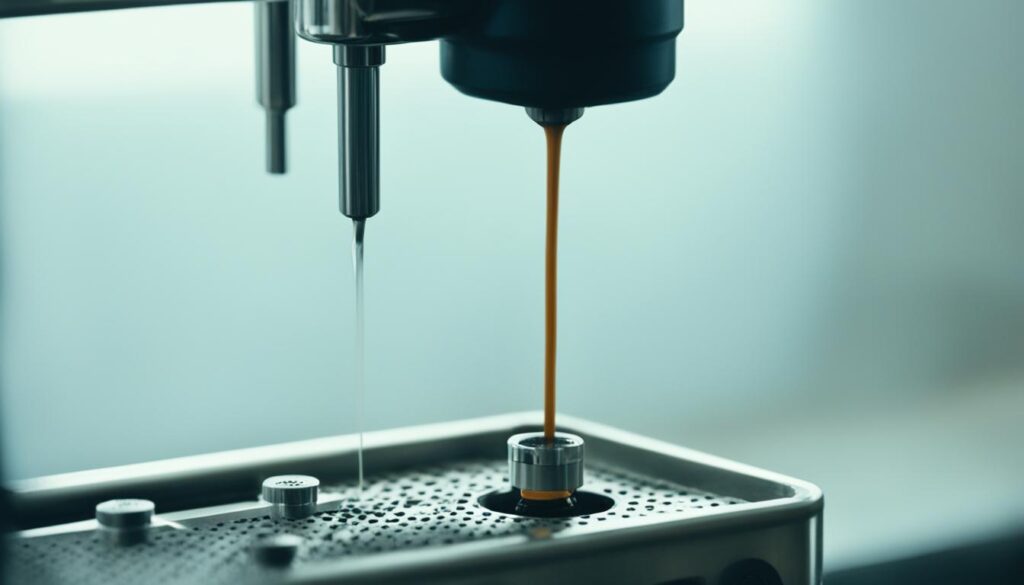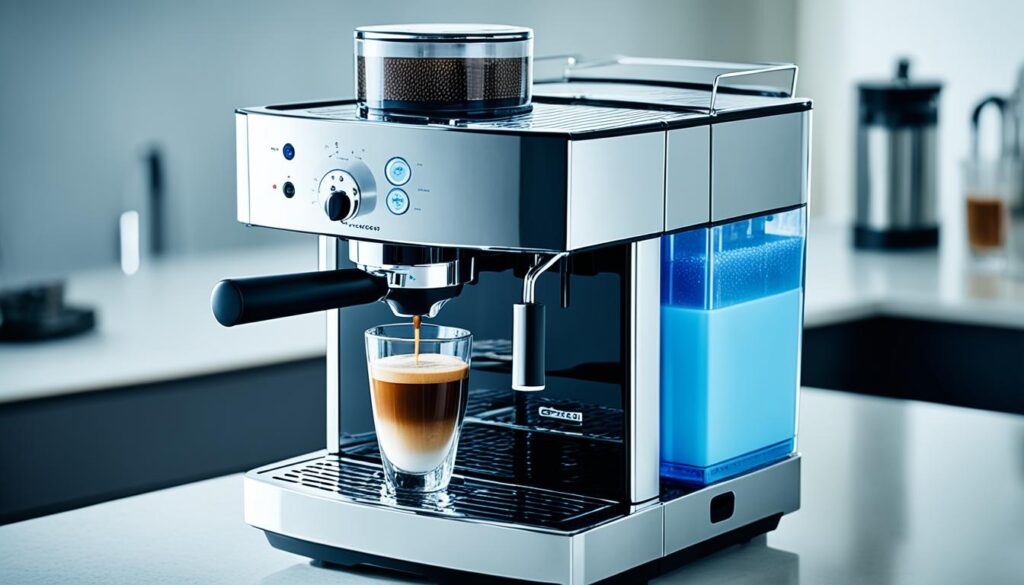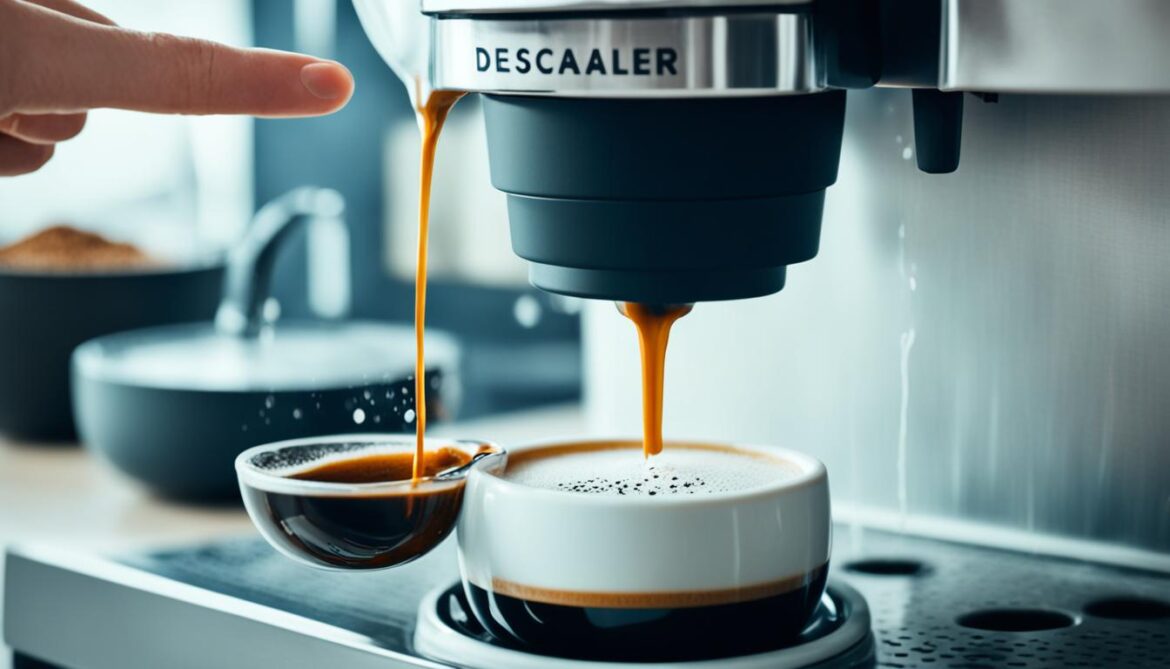If you love coffee, you know a perfect espresso needs top-notch upkeep. Descaling is key for a machine’s health. We’ll guide you from picking the best cleaner to why water type matters. Whether you pick vinegar, citric acid, or a special cleaner, using the right one makes a big difference. Your machine will work better, and your coffee will taste great.
Descaling keeps your espresso maker running smoothly by cutting out limescale. No matter if you’re a pro coffee drinker or just starting, learning to descale is crucial. We’ll explore all the ways to keep your machine at its best, making every morning special.
Key Takeaways
- Maintaining your espresso maker through regular descaling is crucial for optimal function and taste.
- Select an accurate descaling solution for espresso maker, whether you prefer household items like vinegar and citric acid or commercial products.
- Understand the signs when your machine needs descaling and perform the cleaning accordingly to prevent potential damage.
- Post-descaling rinsing is key to ensuring no residue affects your machine’s performance or coffee’s flavor.
- The quality of water plays a significant role in the frequency of descaling needed.
- Best way to descale espresso machine involves thorough preparation, the correct execution of descaling, and finalizing with proper maintenance practices.
Understanding the Importance of Descaling
Descaling is crucial for espresso lovers. Every espresso maker gathers limescale over time. This is a deposit of calcium and magnesium from hard water. It can harm the machine’s performance. But, you can fix this by descaling. Regular descaling is vital for keeping your espresso gear running well.
The Detrimental Effects of Limescale on Espresso Makers
Limescale’s effects on espresso makers start small but can get serious quickly. It blocks the water’s path, which messes with the heating and the espresso’s temperature. This can make your coffee not taste right and brew slowly. It might also cause your machine to break, needing costly repairs.
Impacts on Flavor and Machine Functionality
When we talk about limescale’s effect on flavor, we see big changes. It messes with the temperature, affecting how your coffee tastes. If not treated, it could ruin your espresso’s flavor. Proper descaling keeps your machine working right, making great coffee every time.
| Aspect of Espresso Making | Impact of Limescale |
|---|---|
| Machine Longevity | Decreases, due to increased strain and potential for malfunctions |
| Flavor Consistency | Variable; generally leads to a noticeable decline in taste quality |
| Operational Efficiency | Reduces; more energy required to achieve desired brew temperatures |
| Maintenance Costs | Increases, as frequent repairs or part replacements may become necessary |
Recognizing When It's Time to Descale
It’s key to keep your espresso maker in top shape. Knowing when to descale espresso maker is vital. Descale it at the right time to keep your coffee tasting great and your machine lasting longer. Let’s go over the signs of limescale buildup so you can stay on top of maintenance.
- Reduced water flow – Often the first sign that descaling is needed.
- Decreased water temperature – Indicates scale may be insulating the heating element.
- Unusual noises during brewing – Suggests that water flow is restricted by scale.
- Changes in coffee taste – A clear indicator that your machine’s performance is affected.
Knowing these signs is important. It helps you how to recognize when to descale your espresso maker. This way, you’ll act before things get worse or your coffee’s taste suffers.
See these signs? It’s time to descale. Doing this regularly makes your espresso maker last longer. Plus, it ensures your coffee is always top-notch. Remember these steps. A timely descale is very important!
The Consequences of Neglecting Descaler Maintenance
We often forget how important it is to maintain our espresso makers, especially the descaler. If we don’t take care of this part, our machines won’t last long. Plus, they won’t make coffee as well. Knowing the results of not properly descaling is critical for anyone with an espresso machine. It helps you get the most out of your coffee and saves you money.
Issues with Water Pressure and Heat
Skipping descaling can significantly affect water pressure and heat. This harm makes water heat up and flow less well. The result is poorly made espresso. Hard water’s mineral buildup can block and make water paths smaller. This can reduce pressure and make heating uneven. As a result, your espresso maker might struggle to reach the right temperature and pressure for good coffee. You might end up with coffee that’s too cold and tastes weak and not rich.
Risk of Machine Breakdown from Mineral Buildup
Not descaling your espresso maker can be risky. The worst risk is the machine breaking down completely. If left unchecked, mineral build-up can go from a minor issue to a big problem. It can affect parts such as the heating element and water pump. They might have to work harder and could eventually stop working. Having your machine break down is not just inconvenient; it can be expensive to fix or replace.
Regular descaling is vital because it prevents mineral build-up. This maintenance helps keep your espresso machine working well. It makes your machine last longer and ensures it makes the best coffee.
Selecting the Right Descaling Solution
Choosing the right descaler for your espresso maker is crucial. You have to pick commercial descaling solutions vs DIY alternatives carefully. This choice impacts the descaling’s success, your machine’s life, and how well it works.
Commercial Descaling Solutions vs DIY Alternatives
Commercial descalers are made for coffee machines. They’re safe and effective, ensuring no harm to your machine. They clean mineral build-up fully, leaving no aftertaste in your coffee.
The Risks of Using Vinegar and Other Natural Acids
Vinegar and citric acid might seem easy and cheap, but they’re risky for your machine. They could damage it by being too tough. Bad smells from these can stick in the machine, affecting your coffee’s flavor.
While natural descalers might save money upfront, they could be costly in the long term. They might harm your espresso maker. Let’s compare some key points to see why a commercial descaler is often the better choice:
| Criteria | Commercial Descaler | Vinegar |
|---|---|---|
| Effectiveness | Highly effective, designed for coffee machines | Varies, may not dissolve all mineral deposits |
| Safety for Machine Parts | Safe for use, no corrosive properties | Potentially corrosive, can damage seals and components |
| Residual Taste | No residual taste | Possible lingering taste that affects coffee flavor |
| Cost | Higher initial cost, lower risk of damages | Lower cost, higher risk of expensive repairs |
We all want to save money, but for your espresso maker, choose a commercial descaler. It protects your machine and keeps your coffee tasting great.
Preparing Your Espresso Machine for Descaling
Before starting to descale, it’s important to prepare your espresso machine right. This step makes sure the descaling process works well and your machine stays in top shape for great coffee.
Tools and Materials Needed
To descale your espresso machine effectively, you’ll need certain things. Here’s a list of what you should have:
- Descaler solution specifically designed for espresso machines
- Fresh water to flush through the system
- A cleaning brush to remove any loose scale deposits
- Container to catch any discharged liquids
Safety Precautions and Preliminary Steps
Keeping safe while getting your espresso machine ready for descaling is very important. Let’s go through some safety steps and preparations needed:
- Start by turning off and unplugging your machine to avoid electrical issues.
- Take out any coffee and water, plus all liquids inside the machine.
- Have your machine near a sink or use a container to catch draining liquids.
- Don’t forget your protective gloves since descaling solutions can harm your skin.
With the right tools, materials, and safety measures in place, your espresso machine will be ready for a deep clean. It will then make excellent coffee again.
How to Descale Espresso Maker: The Descaling Process Explained
Doing the descaling process for espresso maker right can make it last longer. It also keeps your coffee tasting great. Here is an easy-to-follow, step-by-step guide to descaling espresso maker. This guide will help anyone through the process with no trouble.

First off, make sure you have everything you need. You’ll need fresh water, a descaling solution, and gloves. This is because the solution is strong. Before you start, take out any coffee, clean the drip tray, and fill the water tank with the solution.
Let’s get into the specific steps now:
- Mix the descaling solution: Follow your espresso maker’s directions to mix water and the descaling solution properly.
- Start the descaling cycle: Turn on the descaling mode on your machine if it has it. You can also run the machine a few times if there is no special mode.
- Let the solution work: After running the cycle, leave the solution to sit for the suggested time. This helps break down limescale.
- Flush the system: Now, empty the reservoir and fill it with fresh water. Run it through the machine a few times to wash out the descaling solution.
| Step | Action | Duration |
|---|---|---|
| 1 | Mix descaling solution with water | 5 minutes |
| 2 | Run descaling cycle | 20-30 minutes |
| 3 | Let the solution sit inside | 30 minutes |
| 4 | Flush system with water | 15 minutes |
Finally, make sure your machine is clean and dry. This finishes the how to descale espresso machine properly process. It also gets your machine ready for your next perfect cup, with no funny tastes.
Post-Descaling: Proper Rinsing and Cleaning
After you descale your espresso maker, the next step is crucial. Proper rinsing improves your coffee’s taste. It also gets rid of left-over descale solution, keeping you safe. Let’s look at the key steps for rinsing your espresso maker after descaling.
Eradicating Residual Descale Solution for Optimal Taste
It’s key to remove any descaling solution left in your espresso maker. Start by flushing it with fresh water. Do this several times with a full water reservoir until you can’t smell the vinegar anymore. This step is important for a pure coffee taste and to keep your machine clean.
Ensuring a Thorough Rinse to Prevent Health Hazards
Rinsing well is also about your health. Chemicals left behind can be dangerous if you drink them. Make sure to rinse your machine properly after descaling. Follow your manufacturer’s rinsing instructions for the best outcome.
In the end, cleaning after descaling is a must. By rinsing your espresso maker well, you get great tasting coffee. You also create a healthy spot to enjoy your coffee. Always follow good rinsing to keep your machine working well and making delicious coffee.
Understanding Water Quality and Its Role in Descaling Frequency
For your espresso maker to run well and make tasty coffee, knowing about water quality is key. Different types of water can make you descale your machine more or less often.
Hard Water vs Soft Water in Espresso Maker Maintenance
Hard water, with more minerals, causes limescale to build up quickly in your espresso maker. Your machine has to work harder when using hard water. This means you need to think a lot about water hardness for descaling your machine.
On the other hand, soft water has fewer minerals. This helps slow down limescale build-up. So, you might not have to descale your machine as frequently.
Filtering Water to Reduce Scaling
Putting in a water filter can help with water quality. It softens water and can make you descale your machine less often. This can make your espresso maker last longer and work better.

Keeping up with maintenance and water quality is super important for espresso makers. The right steps with hard and soft water, and using a filter, help your machine stay in top shape. This way, you get to enjoy the perfect cup of coffee without as many problems.
Maintaining Your Espresso Maker Post-Descaling
After you descale your espresso maker, you need to keep it in top shape. Cleaning it regularly and using it right is crucial. This will make sure your espresso maker lasts for a long time. Here are some tips to help you keep your machine running smoothly.
Regular Cleaning Routines and Best Practices
To keep your espresso maker in good condition, it needs to be cleaned often. This stops coffee oils and dust from building up. Following these steps will make your coffee taste great all the time:
- Clean the drip tray and empty the grounds bin after each use.
- Wipe down the machine exterior daily with a damp cloth.
- Weekly, clean all removable parts with warm, soapy water.
- Monthly, use a coffee machine cleaner to flush out hidden residues.
Tips for Extending the Life of Your Espresso Machine
Along with cleaning, certain tips help your machine last longer. Here are some important ones:
- Always use filtered water to reduce limescale.
- Descale your machine as often as the manufacturer says, based on water hardness.
- After each use, run a water cycle to clear out any coffee grounds.
- Check and replace any worn seals or gaskets to ensure your machine is sealed tight.
By following these best practices for espresso machine maintenance, you’ll enjoy great coffee. An espresso maker in good shape makes all the difference.
| Cleaning Task | Frequency | Importance |
|---|---|---|
| Descaling | Every 1-3 months or as per water hardness | Essential for preventing mineral buildup |
| Daily Exterior Wipe | Daily | Keeps the machine looking new and functional |
| Filter Replacement | Every 2 months | Critical for maintaining water quality and taste of coffee |
| Lubrication of Moving Parts | Annually | Ensures smooth operation and protects against wear and tear |
Conclusion
We’ve come to the end of our guide on descaling espresso makers. We’ve learned how crucial descaling is for your machine. Choosing the right descaling product, knowing when to clean, and doing the process correctly are key. They keep your machine working well. Regular maintenance makes your coffee taste better and your machine last longer.
Regular descaling, proper rinsing, and good maintenance matter a lot. These practices help your machine run smoothly and avoid problems. By taking care of your espresso maker, you’re also taking care of your coffee. So, keeping your machine clean and working well is important for a great coffee experience.
Remember, caring for your espresso maker is more than just keeping it working right. It’s about enjoying a special daily tradition. The right care ensures your coffee is always top-notch. We hope our guide inspires you to care for your machine so it performs well every day. Enjoy descaling and keep making awesome espresso!

